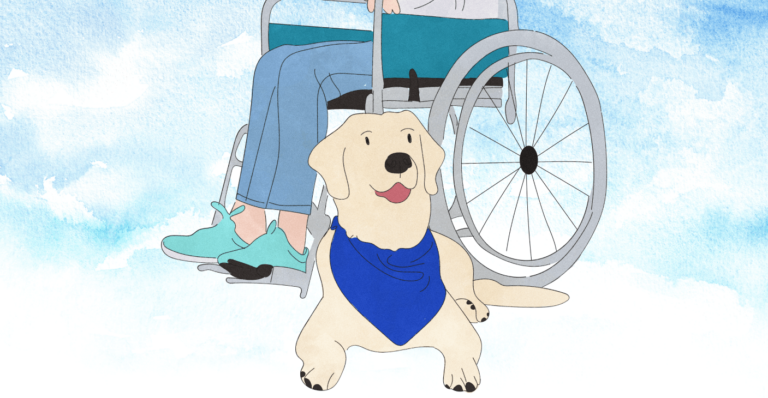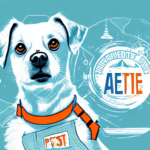What is a Service Dog?
A service dog is a trained animal that helps disabled people have a better quality of life. They provide assistance to people who have physical, sensory, psychiatric, intellectual, and mental disabilities. They perform tasks their owner can’t so they can make their life easier.
Common tasks performed by service dogs include opening doors, switching on a light, helping a visually impaired person to cross the street safely, reminding their owner to take their meds, fetching dropped objects, and much more.

Differences Between Emotional Support Dogs and Service Dogs

Both service dogs and emotional support dogs can help with someone’s mental health. The nature and severity of a disability can determine what the best type of dog is for you.
An emotional support animal provides relief from symptoms associated with a mental illness. ESAs, as part of a wider treatment plan, can help alleviate symptoms associated with a wide range of conditions.
For example stress, depression, PTSD, anxiety, mood disorders, and many other emotional and psychological conditions.
A service dog may help someone with a physical disability and a psychiatric service dog may help someone with a psychiatric disability or severe mental health condition.
For example, their specific training may be to remind a person to take medication. Or the dog can learn to alert or interrupt a person if they show behaviors or symptoms related to their illness.
Public Places
A service animal may enter private establishments like a grocery store or restaurant (as allowed by the American with Disability Act (ADA)) while an ESA cannot.
Training
As most cat and dog owners know, a service animal must be trained. But an ESA does not need special training to become a legal support animal.
Flying and Living
Service animals AND ESAs have the same rights as both can fly or live with their owner free of charge.
Note: Service dog vests and emotional support dog vests are not required but encouraged when traveling or in public places.
The Truth Behind Service Dog Certification
- If you’re confused about what service dog training and certifications are, don’t worry. We’ve come up with these five important facts to help you out.
- A service animal has to be either a dog or a miniature horse. No exceptions!
- The service dog training program these animals go through is very exigent. Service dogs have to become desensitized to mundane distractions, such as loud noises, traffic, and children.
- All service dogs are taught to serve their owner and cater to their disability. This is a crucial part of the service dog training.
- To become a service dog, canines have to attend at least 120 hours worth of service dog training classes. These classes need to be taken within a 6-month period.
- Under the Americans with Disabilities Act (ADA), you don’t need to register your service animal. Stay clear from companies charging you for a so-called service animal certification or registration!
Service Dog Laws and Exceptions
Below are the laws in both America and Canada that protected service animals.

Americans with Disabilities Act (ADA)
Effective since 1990, The American with Disabilities Act (ADA) protects individuals with disabilities from discrimination in all areas of “public life, including jobs, schools, transportation, and all public and private places that are open to the general public”, stated by ADA.
Service Dog Training: A Must
A dog’s ability to learn the specific skills needed to help someone’s disability, and consistently perform in a range of situations is essential. People’s lives and their safety can depend on it.
There are professional organizations that train service dogs for later matching and rehoming. Often the dog has been trained and evaluated for months or years to ensure they are up to the task.
Service Dog Training Near Me
A service dog must go through a service dog training program. This extremely long, complex, and complicated process is not an easy task for every owner.
Service dog training centers are very common in the United States. A simple Google search for “service dog training near me” will show you plenty of results.
4 Ways to Spot a Fake Service Dog
Fake service dogs can be harmful for a number of reasons, including the following:
- Badly trained or unsocialized fake service dogs are often reported for attacking real, working service dogs, especially in cramped spaces that are not set up to accommodate pets other than service animals.
- You’ll never see a highly trained service dog out and about without their leash. Even though they’re obedient and will stay beside their owner, a leash is actually used to protect them. Every service dog owner should know and apply this basic rule.
- Service dogs are trained to keep their owners protected and calm. Even though some dogs are trained to bark for specific reasons, a service dog would never bark out of impatience, or unreasonable behavior.
- Service dogs should not be touched or played with when spotted out with their owners. If you see people playing with one, this could be a sign of a fake service dog.
Service Dog Requirements
Service dog requirements are all about the “T” factor – that is their temperament and their trainability. Some are suited for this special type of service, others, like emotional support animals, simply bring us love, joy, and companionship.





